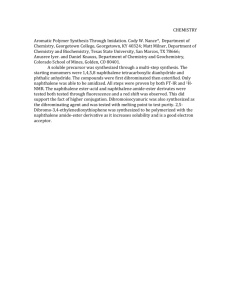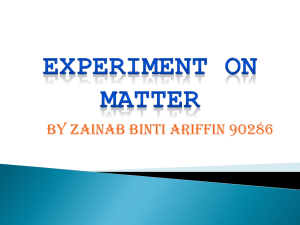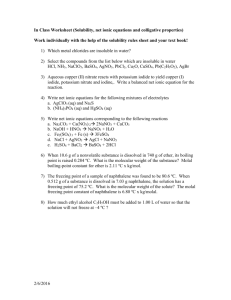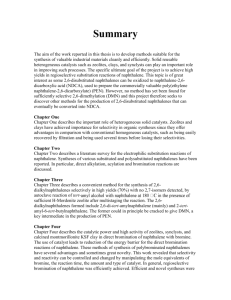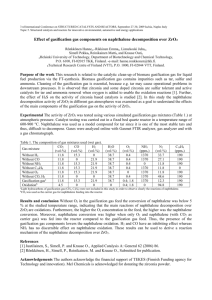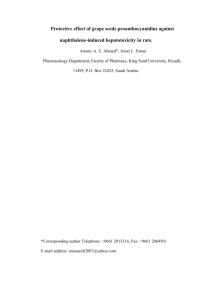Venture Capital by SIDBI for an SME Producing Chemicals
advertisement
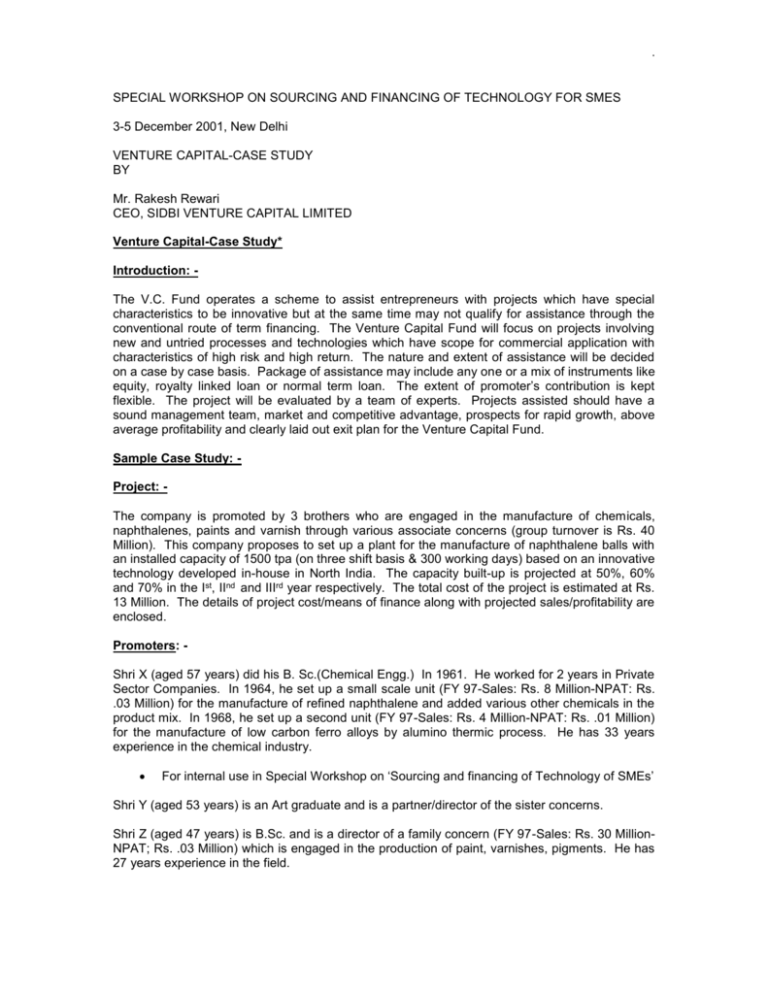
. SPECIAL WORKSHOP ON SOURCING AND FINANCING OF TECHNOLOGY FOR SMES 3-5 December 2001, New Delhi VENTURE CAPITAL-CASE STUDY BY Mr. Rakesh Rewari CEO, SIDBI VENTURE CAPITAL LIMITED Venture Capital-Case Study* Introduction: The V.C. Fund operates a scheme to assist entrepreneurs with projects which have special characteristics to be innovative but at the same time may not qualify for assistance through the conventional route of term financing. The Venture Capital Fund will focus on projects involving new and untried processes and technologies which have scope for commercial application with characteristics of high risk and high return. The nature and extent of assistance will be decided on a case by case basis. Package of assistance may include any one or a mix of instruments like equity, royalty linked loan or normal term loan. The extent of promoter’s contribution is kept flexible. The project will be evaluated by a team of experts. Projects assisted should have a sound management team, market and competitive advantage, prospects for rapid growth, above average profitability and clearly laid out exit plan for the Venture Capital Fund. Sample Case Study: Project: The company is promoted by 3 brothers who are engaged in the manufacture of chemicals, naphthalenes, paints and varnish through various associate concerns (group turnover is Rs. 40 Million). This company proposes to set up a plant for the manufacture of naphthalene balls with an installed capacity of 1500 tpa (on three shift basis & 300 working days) based on an innovative technology developed in-house in North India. The capacity built-up is projected at 50%, 60% and 70% in the Ist, IInd and IIIrd year respectively. The total cost of the project is estimated at Rs. 13 Million. The details of project cost/means of finance along with projected sales/profitability are enclosed. Promoters: Shri X (aged 57 years) did his B. Sc.(Chemical Engg.) In 1961. He worked for 2 years in Private Sector Companies. In 1964, he set up a small scale unit (FY 97-Sales: Rs. 8 Million-NPAT: Rs. .03 Million) for the manufacture of refined naphthalene and added various other chemicals in the product mix. In 1968, he set up a second unit (FY 97-Sales: Rs. 4 Million-NPAT: Rs. .01 Million) for the manufacture of low carbon ferro alloys by alumino thermic process. He has 33 years experience in the chemical industry. For internal use in Special Workshop on ‘Sourcing and financing of Technology of SMEs’ Shri Y (aged 53 years) is an Art graduate and is a partner/director of the sister concerns. Shri Z (aged 47 years) is B.Sc. and is a director of a family concern (FY 97-Sales: Rs. 30 MillionNPAT; Rs. .03 Million) which is engaged in the production of paint, varnishes, pigments. He has 27 years experience in the field. The group concerns re primarily making supplies to various Government Departments. The sister concerns have availed of working capital facilities from one bank. The net profit to sales ratio was low of the sister concerns since they were making bulk supplies to the government in which profit margins are low. Technology: Naphthalene is found in crude form from which it is refined by removing the impurities present in its crude. Conventionally, the naphthalene is refined by a chemical process where crude is treated with acids at higher temperatures followed by several rounds of washing and distillation to recover the refined naphthalene. The company through in-house R&D has developed an innovative eco-friendly refining technique which is a closed loop process. In this process, the crude naphthalene is mixed with some refining agents which dissolves with naphthalene and impurities are separated. Afterwards through condensation, naphthalene and refining agents are recovered separately. The process gives higher yield, recovery of by products with lower process cycle time and does not require major investment in effluent treatment plant. The company has successfully undertaken the pilot plant of 5 kg./day at its existing factory which manufactures naphthalene using conventional technology. The output from the pilot plant was tested in an independent R&D Lab and met the technical specifications. The promoters now propose to upscale this project to the level of 1500 tpa. Plant & machinery: The total cost of plant and machinery has been estimated at Rs. 4 Million. The company has an in-house fabrication department and they propose to fabricate a major part of machinery worth Rs. 2 Million in-house and the balance machinery amounting to Rs. 1.7 Million shall be purchased from outside. The self fabricated equipment consists of MS reaction vessels, MS condensers, cooling tower, S.S. Reactor, blending vessels, etc. the equipment to be procured consists of drum flakers, thermic fluid heater, steam boiler, granulators, tableting machine, etc. The whole fabrication and installation shall be done under the guidance and supervision of Shri A, the group’s technical head who has been instrumental in developing this technology. Shri A (aged 55 years) has done his M. Sc.(Tech.), M. Phil (London) and has 26 years of experience in chemical industry including 6 years experience in U.K. He would be inducted as Director (Technical) on the Board and shares of Rs.50,000 at par would be allotted to him in the company out of the know-how fee of Rs. .1 Million payable to him. The major machinery and their suppliers have been identified and proper balancing will be ensured so as to achieve maximum capacity utilization. Land &civil construction:The project will be located 20 kms. from the town in which the existing units of the company are located. The location will make the company eligible for certain benefits from the State Government which include a subsidy of Rs. 1.3 Million and margin money loan of Rs. 0.3 Million. These benefits have not been included in the means of finance. Utilities:Power:The total power requirement of plant has been estimated at 55 hp. The application for approval and sanction has already been made to the State Electricity Board. The company also proposed to make standby arrangements by installing two D.G. sets of 62.5 KVA and a provision of Rs. 4Milliuon has been made in the project cost. . Pollution control:As the new process is a closed loop process, no effluents will be generated in this plant. The company has already received provisional NOC from the Pollution Control Board. Quality control: The company proposes to go for ISI certification for its product i.e. Naphthalene balls and has made a provision of Rs. 0.5 Millions for laboratory equipments to ensure consistent quality by checking and weighing raw materials and finished goods. Research & Development: The company has an active R&D Department. It has recently developed naphthalene based room freshner cu moth repellent which is being test marketed. Market prospects: Since there is substantial demand for bulk supply of naphthalene balls from various segments [Government Departments, Exporters] the group proposes to increase its market share in this segment since the marketing expenses are only about 1%of sales. The group has recently received an order for supply of 160 tones of naphthalene balls of value of Rs. 6.5 Million from the Government. The company also proposes to introduce naphthalene balls in the consumer market as a branded item. The company’s strategy would be to get the BIS mark for its naphthalene balls and them market this in the retail market. As per the company’s survey, naphthalene balls are not available in the market with BIS specifications. The promoters have identified woolen and leather garment exporters as a major segment which would use high quality naphthalene balls in packaging of their products for exports. The naphthalene balls to be manufactured by the company would not leave any chemical stain on the garments and this would give it a competitive advantage over the supply made by unorganised sector. The naphthalene based air based air freshner-cum-moth repellent developed by the company will company will compete with existing brands (which are para-dichloro benzene based). If the company is able to successfully launch this product by focusing on its longer usage life, twin purpose and lower cost, it would open up a new and profitable market segment. It proposes to initially launch its products in the retail market on a regional basis and gradually expand the geographical coverage. Working capital: The company will be approaching a commercial bank which has given working capital limits to its sister concerns also. Present status: The land has been acquired and civil work has commenced. The company has placed orders for part of plant and machinery. Part of the equipment has already been self fabricated. Implementation schedule is estimated to be 4 months. Returns to Venture Capital Fund: The Venture Capital Fund is making the investment as a combination of royalty linked loan and equity. The funding has been structured to give a return of over 20% on IRR basis on the investment made. Royalty linked loan: - Interest @ 10% p.a. For a period of 2 years and 20% p.a. thereafter. Repayment of principal in 18 quarterly instalments with a moralorium of 18 months. Royalty @ 2% on sales for a period of 6 years. Equity: Since the sanction was made in 1995 when the primary market including bought out deals were active, exit was envisaged through the stock exchange including OTCEI. In addition, undertaking for buy-back of shares was given by the promoters also. Follow-up: It is proposed to appoint a nominee director and outside independent directors on the Board. Regular follow-up visits, periodic follow-up reports were also envisaged. Issues for discussions: 1. Major risk factors associated with the project. 2. Comment on management set up, technology issues, marketing strategy and instrument of finance used by the Venture Capital Fund. 3. Will the project give high returns to the Venture Capital Fund? . ANNEXURE A. COST OF THE PROJECT: (RS. In Million) 1. 2. 3. 4. 5. 6. 7. 8. 9. Land and site development Building Plant and machinery Know-how fees Misc. Fixed assets Preliminary & pre-operative expenses Product launching &pre-operative expenses Provision for contingency Margin money for working capital 1.03 2.83 4.08 0.15 1.15 0.47 1.00 0.46 1.80 TOTAL 12.97 SAY 13.00 B. MEANS OF FINANCE: - 1. Equity [At par] - Promoters V.C. Fund 3.5 2.0 ----- 2. Royalty linked loan from VC Fund 3. PROJECTIONS: - 5.5 7.5 13.00 (RS. In Million) Year ending March 31 50% 60% 35.2 43.1 1.6 3.0 5.5 5.5 Capacity utilisation Sales Net profit after tax Equity Break Even Point : 16.2% IRR : 33% 70% 54.0 4.1 5.5
